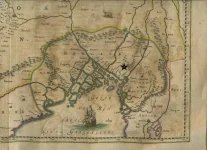Saif
Senior Member
- Joined
- Jan 24, 2024
- Messages
- 15,941
- Likes
- 7,996
- Nation

- Axis Group


Lakutia Zamindar House in Barishal being restored to its original form
The Department of Archaeology has begun restoration work to return the historic Lakutia Zamindar House in Barishal to its original form. By preserving this nearly ruined, palace-like structure, a vital chapter of history, heritage, and architectural style is being brought back to life.
Lakutia Zamindar House in Barishal being restored to its original form
M Jashim Uddin Barishal
Updated: 08 Jun 2025, 18: 51

Restoration work has begun to return the historic Lakutia Zamindar House in Babuganj upazila of Barishal to its former glory. Prothom Alo
The Department of Archaeology has begun work to restore the historic Lakutia Zamindar House in Barishal to its original form. By preserving this near ruined, palace-like structure, a vital chapter of history, heritage, and architectural style is being brought back to life.
Officials from the Barishal Divisional Museum said that the restoration work on the zamindar estate, located in Lakutia of Babuganj upazila, began on 4 May. On-site observations revealed that circular brick pillars are being constructed around the two-story building. The old roof has been demolished and will be replaced with a new one using tiles brought from Satkhira.
Arifur Rahman, assistant custodian of the Barishal Divisional Museum, said that in the first phase, work is focused on the foundation, brick masonry, and roof construction, with a budget of Tk 6 million. However, the antique doors, windows, flooring, and ventilation structures are not included in this phase of the project and may be added in later stages.
Lovely Yasmin, regional director of the Department of Archaeology for the Khulna and Barishal regions, said, “We are trying to restore the building to its original form based on old photographs and historical descriptions.”
According to museum authorities, the Lakutia Zamindar House stands 8.20 meters tall, 25.40 meters long, and 9.20 meters wide. The two-story building contains a total of nine rooms. However, environmentalists believe that the aesthetic appeal of the structure is being compromised by the presence of a warehouse and tractor garage belonging to the Bangladesh Agricultural Development Corporation (BADC) on one side of the property. Seeds are also dried in the paved courtyard behind the building, which they say clashes with the historical ambiance of the archaeological site.
Lincoln Bayen, Barishal divisional coordinator of the Bangladesh Environmental Lawyers Association (BELA), said, “The initiative to preserve this house is highly commendable. But the presence of BADC’s warehouse and structures right next to the zamindar house is seriously undermining its beauty and archaeological significance. These should be relocated elsewhere; otherwise, the site's historical value may be diminished.”
Subhash Chandra Das, legal officer for vested properties at the district administration, said the government has already acquired ownership of nearly eight acres of land surrounding the estate, along with a large pond. If properly preserved by the Department of Archaeology, the site could become a major tourist attraction.
Historical background
Historical records indicate that Zamindar Rupchandra Roy was the founder of the Lakutia Zamindar family. During the time of his grandson, Rajchandra Roy, the estate expanded in both influence and territory. He built the main zamindar house on approximately 49.50 acres of land. It was under Rupchandra Roy—known for his benevolence toward tenants—that a road was constructed from Lakutia to Barishal.
Rupchandra's two sons, Rakhalchandra Roy and Parylal Roy, were followers of the Brahmo religion. Parylal Roy was a prominent barrister and social reformer. His two sons—Indralal Roy, a famous aviator, and Pareshlal Roy, a renowned boxer—are remembered in history for their notable achievements.

An old view of the historic Lakutia Zamindar House in Babuganj upazila of Barishal.Photo: From the family album of Alpana Roy
This zamindar family had a familial connection with the great poet Rabindranath Tagore. The poet's elder brother, the renowned painter Dwijendranath Tagore, had two sons—Arunendranath and Dipendranath—who married Sushila and Charubala, granddaughters of Rajchandra Roy.
It was through the philanthropic efforts of this zamindar family that institutions like Rajchandra College and Pushparani Chowdhury Institution (PRC) were established in Barishal. While the college no longer exists, the school remains active. In later years, zamindar Deben Lal Roy Chowdhury moved to India, where he passed away in Kolkata. His daughter, Mandira Roy Chowdhury, married into the Mukherjee family of Kashipur in Barishal.
On 19 October 2018, Alpana Roy—daughter of Pankaj Roy, a descendant of the zamindar family and a solicitor at Australia’s High Court—expressed concern over the condition of the zamindar house in a letter to Mohammad Sufiur Rahman, Bangladesh’s High Commissioner to Australia. In her letter, she strongly urged that the building be preserved as a historical landmark. Based on this appeal, the Department of Archaeology instructed the Barishal Museum to prepare a proposal, which led to the launch of the restoration project.
Speaking to Prothom Alo, Alpana Roy, now living in Australia, said: “I heard about the history of the zamindar house from my father, Pankaj Roy Chowdhury. In addition to the familial link with Rabindranath Tagore, the well-known contemporary author Arundhati Roy is also connected to this family by lineage. Considering the historical importance of the house, I appealed to the government a few years ago for its preservation. I’m truly delighted to see that it is finally being realised.”
Surrounding the zamindar house are three brick-lined ponds, locally known as “Babur Pukur”. For many years, visitors came to see the building, only to leave disappointed due to its lack of preservation. With restoration now underway, there is renewed hope. People now expect that the building will be fully preserved and adequately protected in the future—so that history comes alive and continues to be passed on from generation to generation.
*This report, originally published in Prothom Alo Bangla online, has been prepared in English by Rabiul Islam.
M Jashim Uddin Barishal
Updated: 08 Jun 2025, 18: 51
Restoration work has begun to return the historic Lakutia Zamindar House in Babuganj upazila of Barishal to its former glory. Prothom Alo
The Department of Archaeology has begun work to restore the historic Lakutia Zamindar House in Barishal to its original form. By preserving this near ruined, palace-like structure, a vital chapter of history, heritage, and architectural style is being brought back to life.
Officials from the Barishal Divisional Museum said that the restoration work on the zamindar estate, located in Lakutia of Babuganj upazila, began on 4 May. On-site observations revealed that circular brick pillars are being constructed around the two-story building. The old roof has been demolished and will be replaced with a new one using tiles brought from Satkhira.
Arifur Rahman, assistant custodian of the Barishal Divisional Museum, said that in the first phase, work is focused on the foundation, brick masonry, and roof construction, with a budget of Tk 6 million. However, the antique doors, windows, flooring, and ventilation structures are not included in this phase of the project and may be added in later stages.
Lovely Yasmin, regional director of the Department of Archaeology for the Khulna and Barishal regions, said, “We are trying to restore the building to its original form based on old photographs and historical descriptions.”
According to museum authorities, the Lakutia Zamindar House stands 8.20 meters tall, 25.40 meters long, and 9.20 meters wide. The two-story building contains a total of nine rooms. However, environmentalists believe that the aesthetic appeal of the structure is being compromised by the presence of a warehouse and tractor garage belonging to the Bangladesh Agricultural Development Corporation (BADC) on one side of the property. Seeds are also dried in the paved courtyard behind the building, which they say clashes with the historical ambiance of the archaeological site.
Lincoln Bayen, Barishal divisional coordinator of the Bangladesh Environmental Lawyers Association (BELA), said, “The initiative to preserve this house is highly commendable. But the presence of BADC’s warehouse and structures right next to the zamindar house is seriously undermining its beauty and archaeological significance. These should be relocated elsewhere; otherwise, the site's historical value may be diminished.”
Subhash Chandra Das, legal officer for vested properties at the district administration, said the government has already acquired ownership of nearly eight acres of land surrounding the estate, along with a large pond. If properly preserved by the Department of Archaeology, the site could become a major tourist attraction.
Historical background
Historical records indicate that Zamindar Rupchandra Roy was the founder of the Lakutia Zamindar family. During the time of his grandson, Rajchandra Roy, the estate expanded in both influence and territory. He built the main zamindar house on approximately 49.50 acres of land. It was under Rupchandra Roy—known for his benevolence toward tenants—that a road was constructed from Lakutia to Barishal.
Rupchandra's two sons, Rakhalchandra Roy and Parylal Roy, were followers of the Brahmo religion. Parylal Roy was a prominent barrister and social reformer. His two sons—Indralal Roy, a famous aviator, and Pareshlal Roy, a renowned boxer—are remembered in history for their notable achievements.
An old view of the historic Lakutia Zamindar House in Babuganj upazila of Barishal.Photo: From the family album of Alpana Roy
This zamindar family had a familial connection with the great poet Rabindranath Tagore. The poet's elder brother, the renowned painter Dwijendranath Tagore, had two sons—Arunendranath and Dipendranath—who married Sushila and Charubala, granddaughters of Rajchandra Roy.
It was through the philanthropic efforts of this zamindar family that institutions like Rajchandra College and Pushparani Chowdhury Institution (PRC) were established in Barishal. While the college no longer exists, the school remains active. In later years, zamindar Deben Lal Roy Chowdhury moved to India, where he passed away in Kolkata. His daughter, Mandira Roy Chowdhury, married into the Mukherjee family of Kashipur in Barishal.
On 19 October 2018, Alpana Roy—daughter of Pankaj Roy, a descendant of the zamindar family and a solicitor at Australia’s High Court—expressed concern over the condition of the zamindar house in a letter to Mohammad Sufiur Rahman, Bangladesh’s High Commissioner to Australia. In her letter, she strongly urged that the building be preserved as a historical landmark. Based on this appeal, the Department of Archaeology instructed the Barishal Museum to prepare a proposal, which led to the launch of the restoration project.
Speaking to Prothom Alo, Alpana Roy, now living in Australia, said: “I heard about the history of the zamindar house from my father, Pankaj Roy Chowdhury. In addition to the familial link with Rabindranath Tagore, the well-known contemporary author Arundhati Roy is also connected to this family by lineage. Considering the historical importance of the house, I appealed to the government a few years ago for its preservation. I’m truly delighted to see that it is finally being realised.”
Surrounding the zamindar house are three brick-lined ponds, locally known as “Babur Pukur”. For many years, visitors came to see the building, only to leave disappointed due to its lack of preservation. With restoration now underway, there is renewed hope. People now expect that the building will be fully preserved and adequately protected in the future—so that history comes alive and continues to be passed on from generation to generation.
*This report, originally published in Prothom Alo Bangla online, has been prepared in English by Rabiul Islam.




































